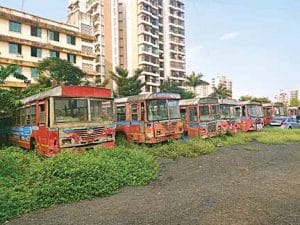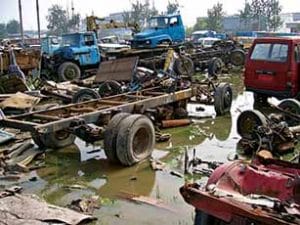With scrappage policy back in news, attention to ELVs is made necessary once again.
Story by Team CV
A visit to Delhi’s Mayapuri scrap market or Mumbai’s scrap market, and the unorganised nature of India’s scrappage industry is at once apparent. No norms of scientific disposal of waste are followed. A good part of what could be recycled is lost, degrading the soil in the region and contaminating water streams and various natural resources in the region. Not counting the damage it would cause to the human beings working there. Any estimate about environment recuperation is hard to come by, and a reason enough to encourage the proliferation of an organised End-of-Life Vehicle (ELV) industry. In 2015, the Automotive Indian Standard Committee under Ministry of Road Transport and Highways (MoRTH) framed the Automotive Industrial Standard 129 (AIS 129) for reuse, recycling and material recovery from autos. Since then, the focus of Indian auto industry has increasingly turned to designs that support vehicle refurbishment or recycling. They have outlined the role of material designers; the role of material advancements at the component design stage, and at the manufacturing stage.

All this is however not as easy as it sounds. There’s an amount of complex engineering attached to it. There’s the traceability chain that runs from the raw material to the automobile nearing the end of its life. It is not devoid of challenges, but also the one with growing opportunities. The importance of the automotive recycling industry set to grow exponentially as the announcement of a scrappage policy would add more value or cash to it, technology would be the driver of the future. It would help maintain the standards of auto recycling practices specified by the government. With education and training, insurance, and salvage poised to be the key drivers of the scrappage industry in India, much like they are in even the most advanced markets of the world, a brighter and safer future beacons. Especially for those who work in the current scrap markets with little knowledge or awareness for what they are exposed to; the amount of radiation or hazardous materials that they are exposed to. Clearly, the current ELV recycling scenario in India is not the best.
India’s ELV recycling scenario
 A visit to Delhi’s Mayapuri scrap market and it does not take long to understand the grim conditions under which people work. The air standards could be easily worse than those that often prevail in the capital city. Against the fast rising number of vehicles in the region, it does really bode well. Not until scientific ways to deal with ELVs are found and invested in. Expressed Ashim Sharma, Partner and Group Head, Business Performance Improvement Consulting (Auto, Engg. & Logistics), Nomura Research Institute, that India would have more than 22 million ELVs by 2025. They would have a potential to generate Rs.32,700 crore worth of scrap value, he added. Of the opinion that 1.2 million heavy trucks and buses at a scrap volume of two million tonnes would be valued at Rs.8000 crore, Sharma averred that setting up of organised recycling facilities for ELVs makes for ample business opportunity. Pointing at 0.7 million three-wheelers producing a scrap volume of 0.3 million tonnes valued at Rs.700 crore, he stated that efforts to build an organised scrappage industry in the country would result in significant raw material savings, landfill space-saving and job creation.
A visit to Delhi’s Mayapuri scrap market and it does not take long to understand the grim conditions under which people work. The air standards could be easily worse than those that often prevail in the capital city. Against the fast rising number of vehicles in the region, it does really bode well. Not until scientific ways to deal with ELVs are found and invested in. Expressed Ashim Sharma, Partner and Group Head, Business Performance Improvement Consulting (Auto, Engg. & Logistics), Nomura Research Institute, that India would have more than 22 million ELVs by 2025. They would have a potential to generate Rs.32,700 crore worth of scrap value, he added. Of the opinion that 1.2 million heavy trucks and buses at a scrap volume of two million tonnes would be valued at Rs.8000 crore, Sharma averred that setting up of organised recycling facilities for ELVs makes for ample business opportunity. Pointing at 0.7 million three-wheelers producing a scrap volume of 0.3 million tonnes valued at Rs.700 crore, he stated that efforts to build an organised scrappage industry in the country would result in significant raw material savings, landfill space-saving and job creation.
Explaining that an estimated 2.8 million four-wheelers at a scrap volume of three million-tonnes would be valued at Rs.14000 crore, Sharma touched upon ELV recycling scenario at present. He said that it was like a linear economy. Drawing attention to the fact that 17.8 million two-wheelers at a scrap volume of 2.1 million tonnes would be valued at Rs.100,000 crore, he added that a circular economy would focus on collecting an ELV in an organised manner before recycling it and meeting the objective of maxim material recovery to minimise waste. Explaining further that the replacement of older vehicles with newer ones would result in a direct and indirect reduction in environmental pollution, Sharma highlighted the ecological impact of the same too. “Vehicular emission is a significant contributor to environmental pollution. Older vehicles, heavy-duty ones especially, have significantly higher emissions levels than newer vehicles,” he said.
Of the opinion that production processes of virgin materials, involving mining activities especially, account for significant greenhouse gas emissions such as CO2, Sharma averred that the recycle material has a much lower carbon footprint in comparison. Stressing on essential policy documents and guidelines having been released in the last few years to organise the market and harness its full potential, he informed that ELV recycling would also contribute towards less waste dumping in landfills apart from saving valuable forex reserves. An entry into ELV recycling will create a win-win situation for OEMs irrespective, Sharma quipped. He explained that though OEMs have exchange schemes to offer, the economics of these schemes has scope to improve further once organised recycling picks up. Of the opinion that inventory management at the dealership will also get better, Sharma averred that they could act as collection centres. Stating that scrap part selling will reduce raw materials cost and import duties, it would also help them with an eco-friendly tag, he added.
Global Scenario
Pointing at ELV recycling mechanisms across major global geographies, Ashim Sharma informed that these are regulated by national-level legislation. The industry-driven USA model is an exception, he added. As far as the global scenario is concerned, China is said to be closest to India in terms of ELV PARC. The fact, however, that the industry maturity is very low in China, is claimed to make it an inappropriate reference point. Instead, Europe and Japan are the best reference points for India. Around 70 to 80 per cent of vehicles are recycled in Europe and Japan. There are large scale recyclers in these markets. There are large scale recyclers in the US too. A smaller informal sector constitutes the rest. Taking a leaf out of these markets and how they operate, India could work out lucrative consumer incentives and extend producer responsibility as a contributor to the success of the entire process.
The process of recycling being the same until the shredder is a part of it, the ELV industry in Europe and Japan are quite mature in their own way. They have a well-constituted post-shredding process in place too. What makes them a very good reference point most of all is their ability to recover 80 and 85 per cent material. Credit should go to the R&D progress concerning autos in these markets. For the Indian market to get to a stage where the scrappage market is as organised and as effective, there is a need to learn a lot. There is a need to streamline the process involving ELV collection as well as dismantling. Even with many small players in the fray, a market like India could gain from a cooperative effort. An effort that would ensure that a working society structure is achieved, which jointly invests in the stipulated processes and adheres to the guidelines; which jointly invests in machines and the other bits needed to achieve the required performance and safety standards. This would also aid in higher material recovery and in-turn better earning-ability.
CERO recycling
Stressing upon the need to build an ELV industry that is organised and competitive in comparison to their counterparts in markets like Europe and Japan, Summit Issar, Managing Director, Mahindra Intertrade Ltd., expressed that stakeholders should tap the potential of organised recycling. This is essential in view of the projected ELV volumes of 36.4 million cars and CVs by 2025 from the current 22.7 million, he added. Drawing attention to India importing close to seven million-tonnes of scrap steel every year due to the gap in domestic demand and supply, Issar averred, “The unorganised scrappage processes in India are currently unsafe when it comes to the disposal of hazardous waste.” “The process lacks a scientific basis and transaction transparency as well,” he added. Of the opinion that an efficient recycling process could provide benefits, Issar informed that efficient recycling could help save energy, reduce emissions, conserve resources, preserve foreign exchange and create employment as well.
 Stating that CO2 emissions are reduced by 58 per cent through the use of ferrous scrap, Issar mentioned that his company is chalking out a plan to invest in 25 shredding units across India. It would roughly entail an investment of Rs.1000 crores and help create many jobs. Citing the example of Toyota for the development of easy to dismantle wiring harnesses that are also easy to reclaim in an ELV, Dr. Regina Kohlmeyer, Scientific Officer, German Environment Agency UBA, said that international policies and practices for eco-efficiency in the ELV management process are fast emerging. Stating that the easy to dismantle wiring harness found on Toyota vehicles eliminate the need to interfere with other components, Dr Kohlmeyer informed that Volvo is aiming at 25 per cent plastic recycling capability for cars by 2025. Explaining that there is a need to adopt an approach where recycling of material at the end-of-life is taken into consideration right at the design stage, Dr Kolhmeyer said that the European circular economy plan 2020 has a new framework for recycling of batteries. It would be proposed in the EU and prove to be a good benchmark for others to follow, she added.
Stating that CO2 emissions are reduced by 58 per cent through the use of ferrous scrap, Issar mentioned that his company is chalking out a plan to invest in 25 shredding units across India. It would roughly entail an investment of Rs.1000 crores and help create many jobs. Citing the example of Toyota for the development of easy to dismantle wiring harnesses that are also easy to reclaim in an ELV, Dr. Regina Kohlmeyer, Scientific Officer, German Environment Agency UBA, said that international policies and practices for eco-efficiency in the ELV management process are fast emerging. Stating that the easy to dismantle wiring harness found on Toyota vehicles eliminate the need to interfere with other components, Dr Kohlmeyer informed that Volvo is aiming at 25 per cent plastic recycling capability for cars by 2025. Explaining that there is a need to adopt an approach where recycling of material at the end-of-life is taken into consideration right at the design stage, Dr Kolhmeyer said that the European circular economy plan 2020 has a new framework for recycling of batteries. It would be proposed in the EU and prove to be a good benchmark for others to follow, she added.
Calling for a need to revise the European circular economy action plan 2.0, Silvia Vecchione, Senior Environmental Policy Manager, European Automobile Manufacturers’ Association (ACEA), mentioned that there was a need to revise rules to reduce virgin material consumption and eliminate waste generation as well as the resulting pollution. A harmonised system could help better manage information on substances of concern along the supply chain, she explained. Of the opinion that it is necessary to identify substances of concern in waste streams, Vecchione stressed on the need for better enforcement. Said Dr Hans-Rainer Lotz, Recycling bei Volkswagen AG, that OEMs have to look at possible means to turn recycling into a more comfortable and less hazardous process. He added, “As per the directive of the European Parliament and the council on ELV (2000), treatment-related requirements include environmental and technical standards for pre-treatment (removal of fluid and airbags) and dismantling.”

As per the European Parliament directive, the design requirement for new vehicles must take into full account and facilitate the dismantling, reuse and recovery, including components and the materials used. “The directive,” according to Dr Lotz, “suggests less use of hazardous substances in vehicles with restrictions on Mercury (Hg), Cadmium (Cd), Lead (Pb) and Chromium (Cr).” Of the opinion that it becomes challenging for OEMs, as well as expensive, to follow such a process, he averred that the Volkswagen ‘Internal Standard 99000’ policy makes dismantling an easy process, in compliance with the legal requirements. Urging OEMs to liaise with material equipment manufacturers, Dr Lotz said that there is a need to integrate high-quality recycled materials and other parts to help the market mature. Citing the European Parliament’s European Circle Plastic Alliance, he highlighted the Volkswagen Groups’ commitment through active participation in group activities including supplier exhibits of recycled materials complying to group standards like the component and material coding suited to reuse and recovery.






















